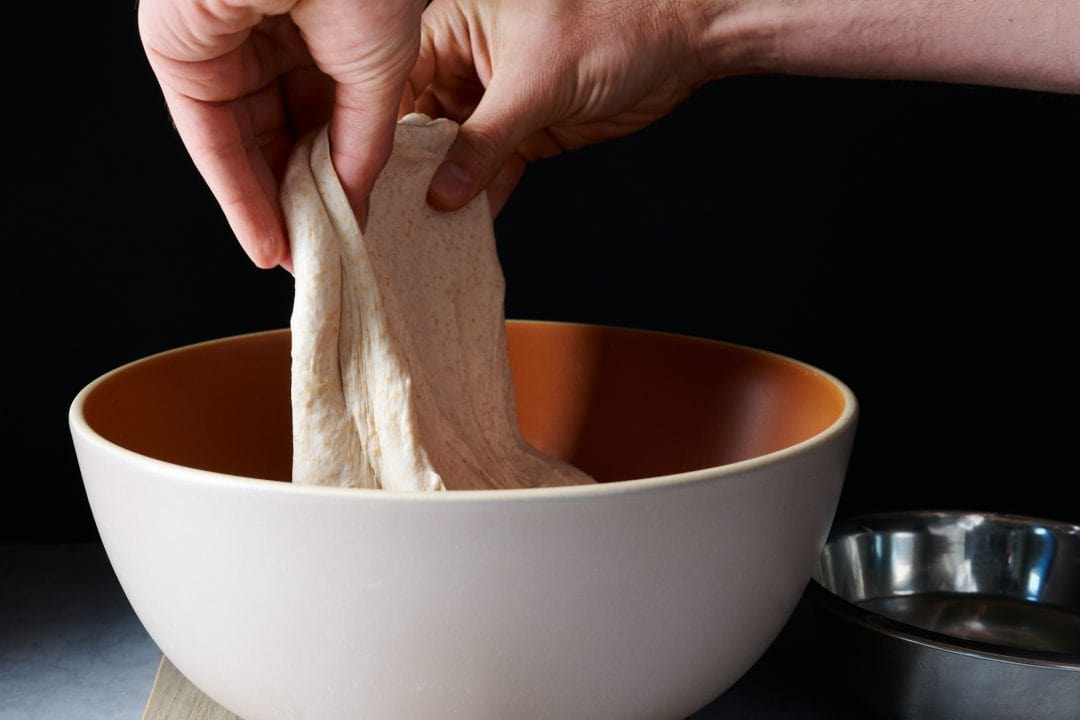High-protein white bread flour is one of the many classes of flour that can be used for baking sourdough bread. But it’s not quite as straightforward to work with as others in the baking aisle: Strangely, what exactly makes flour “high-protein” is ambiguous. Further, in my experience, using too much of this flour (or using it incorrectly) can lead to bread with a tough, gummy texture; and potentially a dense or wildly open crumb structure—none of which we want in a loaf.
I do not intend this guide to be a statement about how high-protein flour is bad and should never be used because that’s false.
High-protein flour is often considered perfect for bread because bread bakers strive for the most volume, a loaf with a tall rise, and often an open and light crumb structure. A flour with a high protein content suitable for breadmaking (some flour can be high in protein but not as effective as other modern wheat, like Khorasan, at trapping gasses) can certainly help with all these things. I like to think of high-protein white flour as the metal frame construction of home building: It creates a tall, strong structure that can resist deformation and breakdown, especially during proofing (and will help you avoid that collapsed loaf during baking, too).
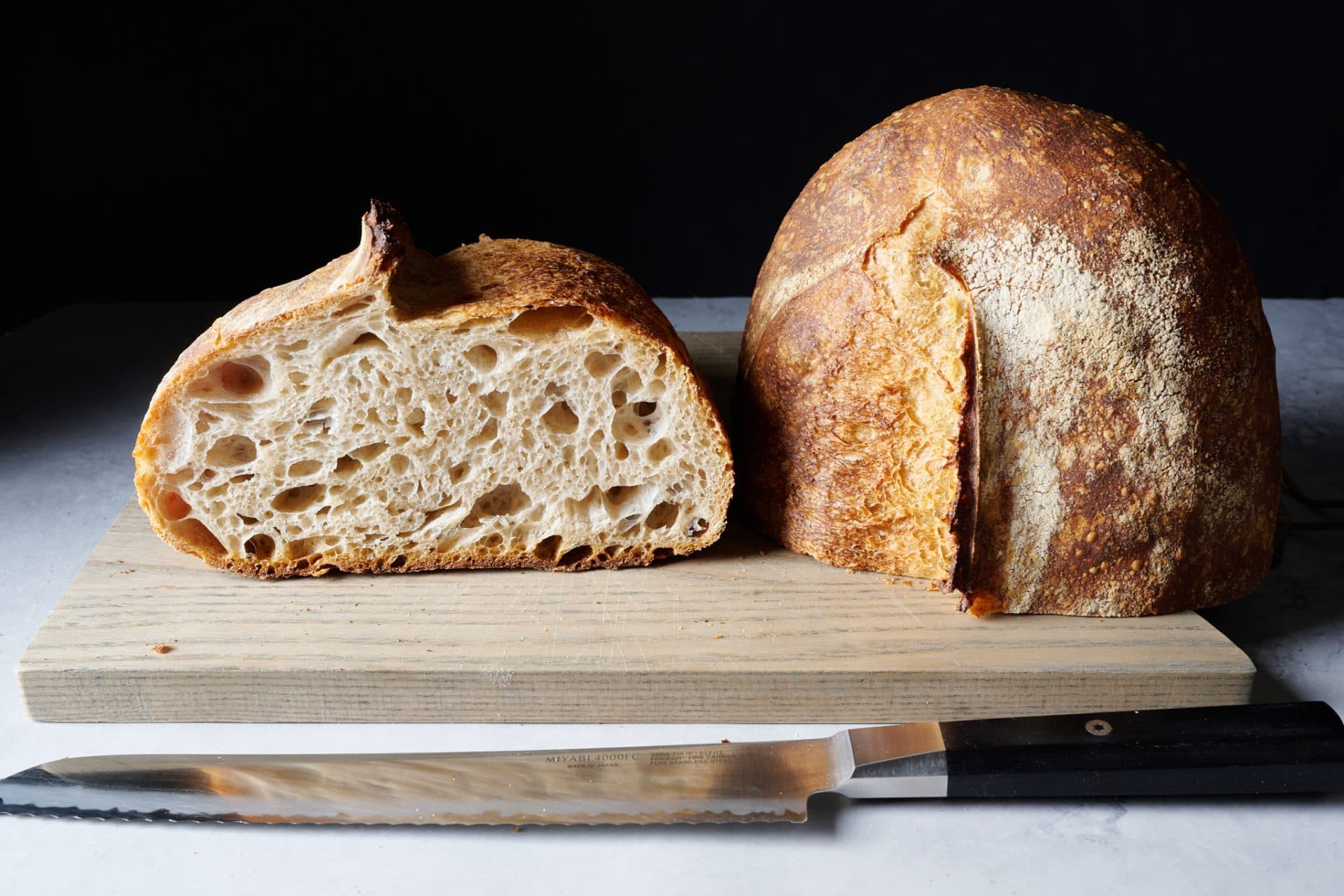
But in my experience, using large percentages of this flour (which you’ll often find in beginner recipes) has textural downsides if not correctly accounted for in a bread formula and process—which we will look at soon. Such as recipes for a lean dough (one without butter, eggs, or sugar, such as standard free-form sourdough loaves) can have a leathery crust and a tough, chewy crumb. Contrast this with a loaf made with the same technique, but a medium-protein white flour—a flour around 11-12% protein, such as all-purpose flour—that exhibits a tender, melt-in-your-mouth quality.
Additionally, depending on where you live, high-protein white bread flour may be the predominant flour available to you—this is especially true in North America, particularly Canada, where most of the grain grown is strong wheat. In these locations, even an all-purpose flour may be high-protein. Be sure to check the flour bag (or with the miller) to determine the protein percentage so you know what you’re working with. Regardless, learning to work successfully with this class of flour is essential.
I do not intend this guide to be a statement about how high-protein flour is bad and should never be used—because that’s false. (When I was baking in France, the running joke was that the only flour you can find in the USA is high protein.) When used correctly, it can be an asset in the bread baker’s toolkit, resulting in bread that has a tall rise, delicate crumb, and delicious flavor.
Let’s look at how to accomplish all these things, but first, I need to define what I consider high-protein white flour.
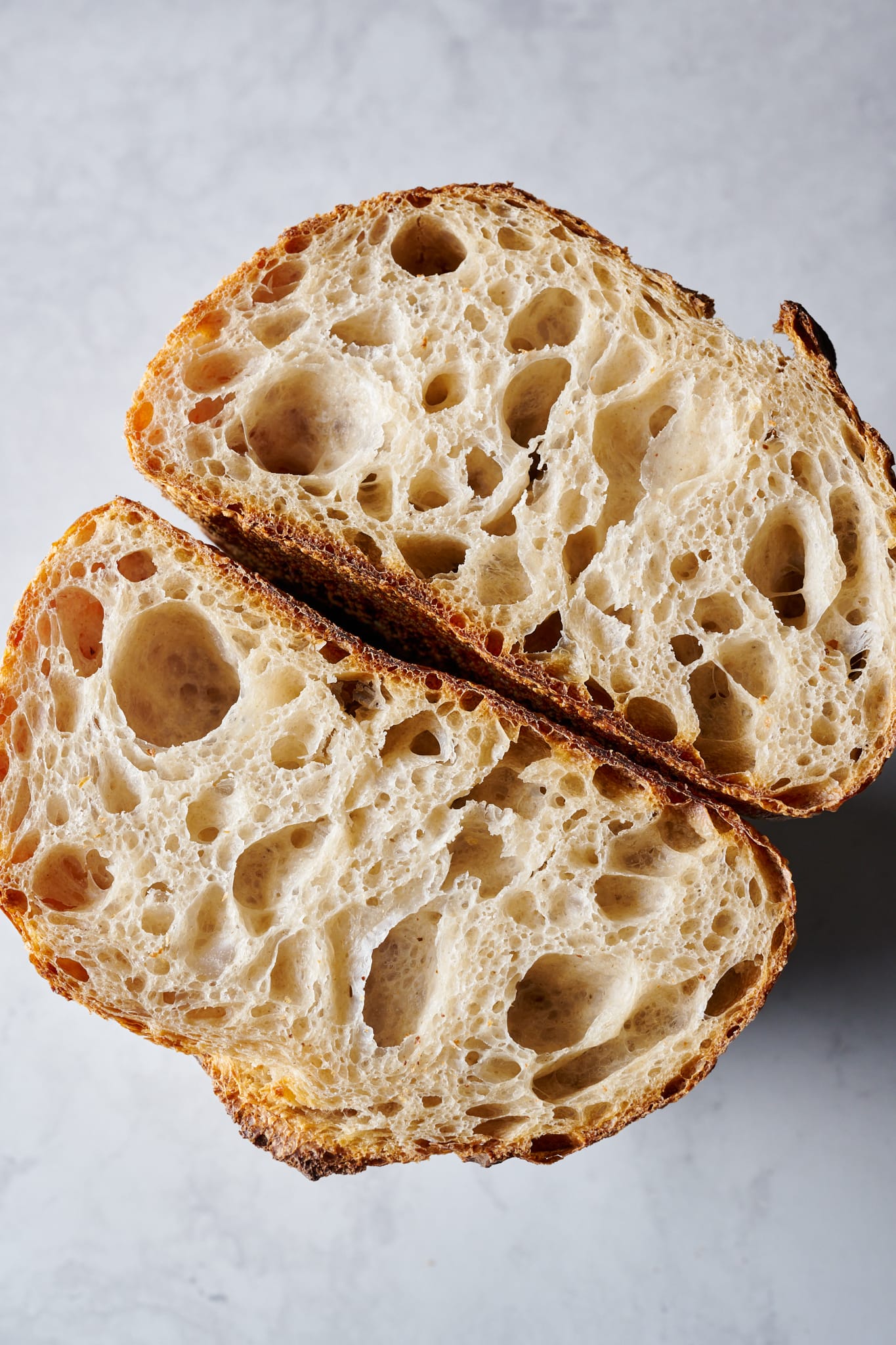
The bread shown above was made with 100% high-protein white bread flour. The recipe and technique can be found in my downloadable Sourdough Bread Baker’s Handbook (including the formula spreadsheet).
What Is High-Protein White Bread Flour?
There’s no agreed-upon percentage that says one flour is high protein versus medium or low protein. But generally, I consider high-protein white bread flour to have a protein percentage from about 12.7% to 14% or even higher. This protein range includes typical “bread flour” as labeled in the United States.
Many millers will indicate the protein percentage of flour on the bag, but if not, a quick search at their website or even an email out to them directly will lead you to the result.
High-protein white flour is useful in recipes that require more chew, a strong structure, or highly enriched doughs. Here are a few examples where I like to use high-protein white bread flour:
- Bagels (strong flour and low hydration give bagels their characteristic chew)
- Pretzels (strong flour helps bring chew and makes shaping and handling easier)
- Focaccia (my highly hydrated focaccia benefits from a strong structure)
- Free-form loaves with lots of mix-ins (like my Jalapeño-Cheddar sourdough bread)
- Bomboloni (Sourdough Doughnuts) (highly enriched with butter)
- Sourdough Cinnamon Rolls (highly enriched with butter and sugar)
See below for some examples of my favorite brands of high-protein flours.
What is “Bread Flour”?
In the United States, the term “bread flour” is used for white flour with high protein content. There isn’t a set protein percentage, but typically, I see this flour containing at least 12% to 13% protein. Essentially, bread flour is high-protein white bread flour. The most notable example of this flour is King Arthur Baking Bread Flour, at 12.7% protein; whereas King Arthur Baking All-Purpose Flour is 11.7% protein.
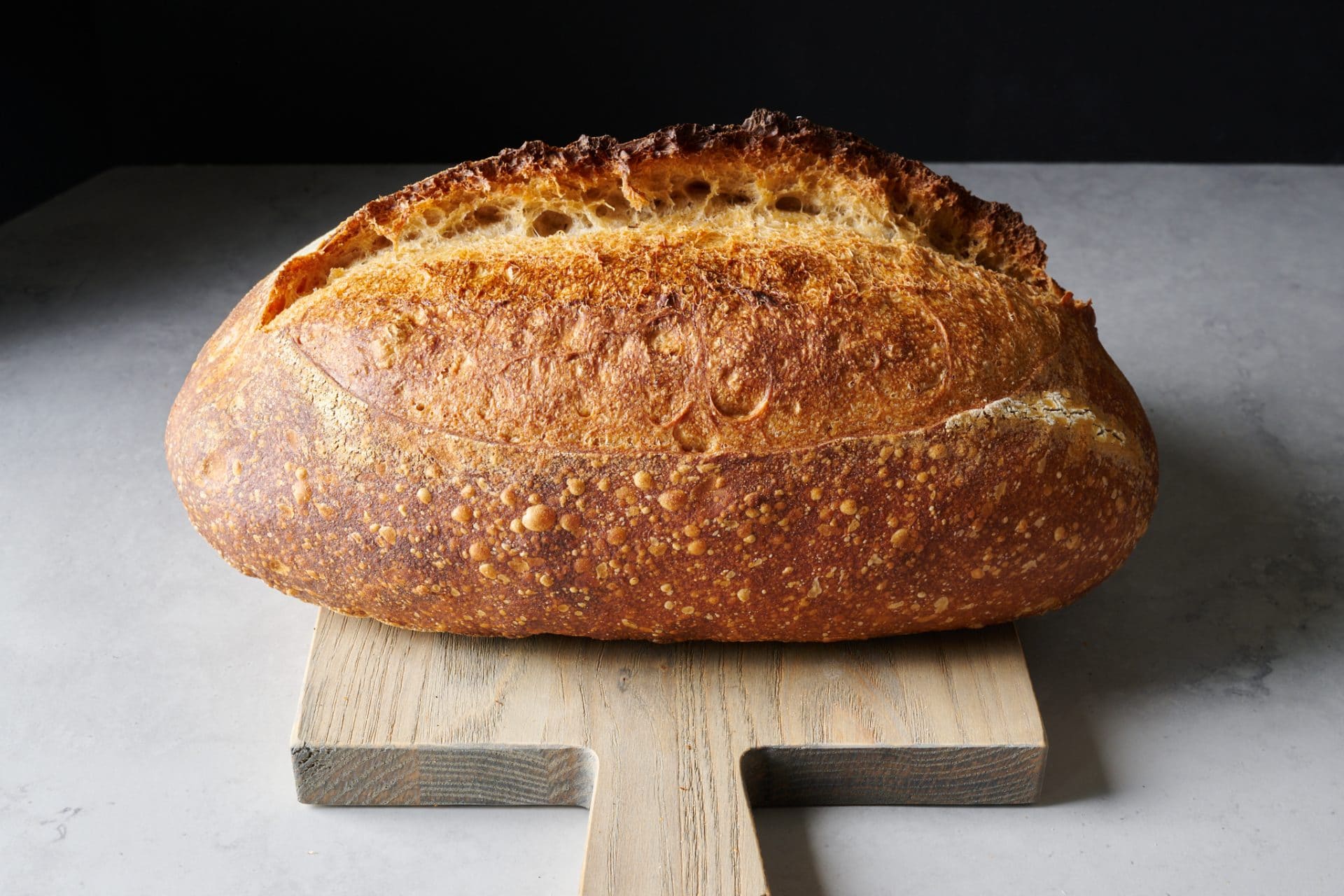
Why Is Whole Wheat Flour High-Protein?
Whole wheat flour is high in protein because it contains the entire wheat berry, including the bran, endosperm, and germ. Bran is naturally high in protein. Typically, whole wheat flour protein percentages range from 13% to 15% or higher. (For reference, King Arthur Baking Whole Wheat Flour is 14% protein.)
However, unlike high-protein white flour, whole wheat flour will not produce a loaf with ample volume and an open, light interior. But what is sacrificed in terms of volume is more than made up for in terms of flavor and added nutritional value.
If you’re using whole wheat flour and still want a tall rise, you could blend it with an all-purpose or bread flour to get the best of both worlds. This is precisely what I do in my Fifty-Fifty Whole Wheat Sourdough Bread recipe—and it results in bread with incredible flavor and nutrition, as well as a tall rise and open interior.
High-Protein White Bread Flour Benefits and Uses
In a nutshell, these are the benefits of using high-protein white bread flour:
- Provides extra structure and support to a dough
- Makes a dough that better handles long fermentation times before breakdown
- Gives the final product a taller rise and more volume
- Adds chewiness to the final product
I use high-protein white bread flour for any dough that needs extra structure, especially doughs that have a high number of inclusions like fruit or nuts (like my Dark Chocolate-Cherry Sourdough) or doughs that are heavily enriched with butter, egg, or sugar (shokupan/Japanese milk bread is a great example). The high protein content of this flour gives the dough added strength to hang on to and support these additions while still resulting in a bake that rises high.
Perhaps the most well-known use for high-protein flour is for bagels. When eating a bagel, you expect a product with high density and extra chew. For this reason, my bagel recipe calls for 100% high-protein white bread flour (personally, I like Central Milling High Mountain’s)—and it certainly delivers a chewy result.
While high-protein flour has benefits and uses, it also has drawbacks.
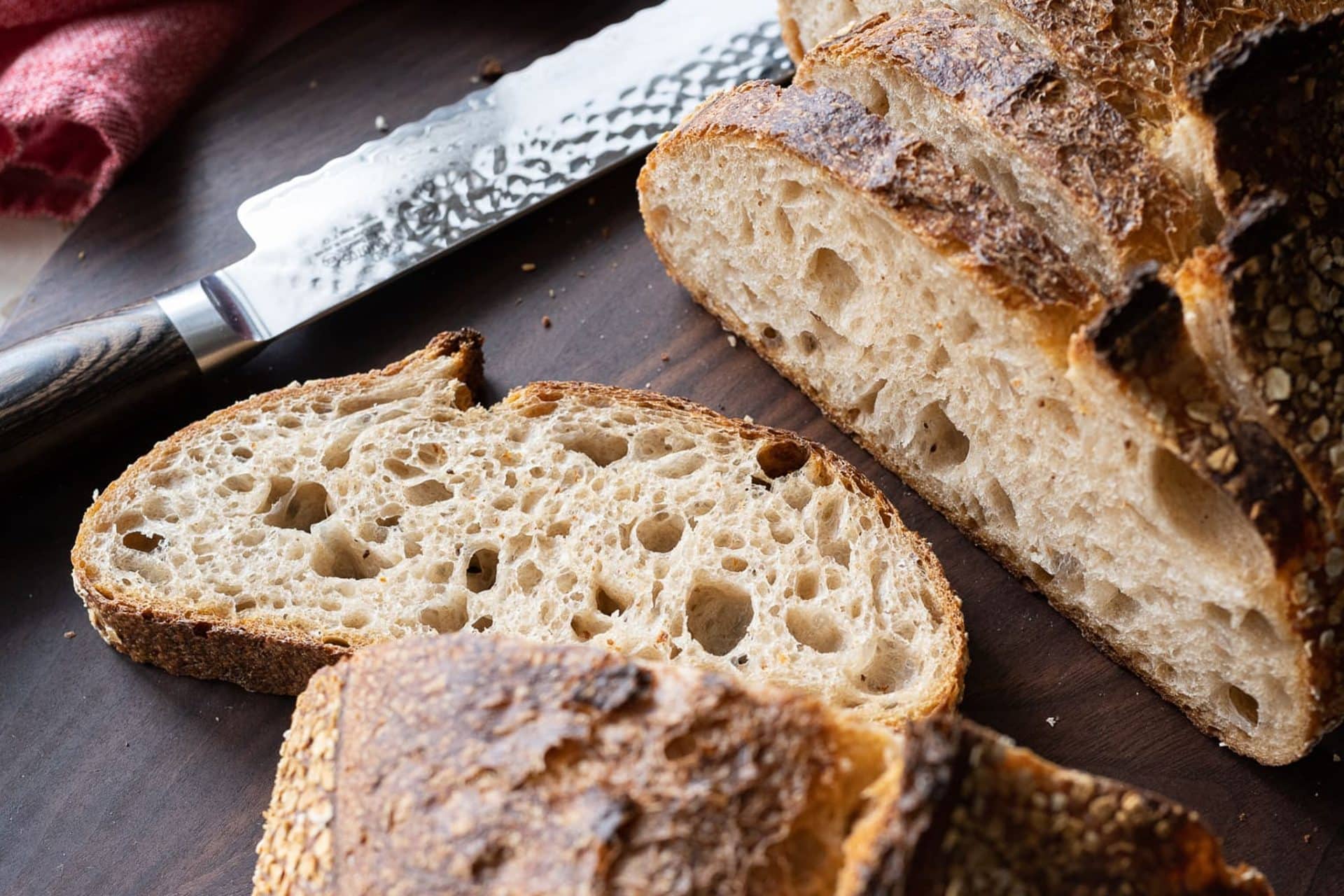
The Top 3 Reasons I Use As Little High-Protein White Bread Flour as Possible
When used excessively, high-protein flour can lead to undesirable textural aspects in a final loaf of bread.
In my baking, I always approach a formula with the intention to use as little high-protein white bread flour as possible, relying on other formula changes (like a reduction in dough hydration) to help bring dough strength and stability.
Here are a few reasons why I try to minimize using this flour.
(1) Avoid A Gummy Crumb
This is my primary reason for limiting high-protein white bread flour in my freeform loaves. Due to the high protein content of the flour, I find that when using high percentages in a lean dough (one without enrichments like butter, egg, and sugar, such as a free-form table loaf), the result usually has a gummy crumb, also known as a viscous, sticky, and tough interior. It’s almost like the bread has gone prematurely stale.
(2) Avoid A Tough, Chewy Texture
This ties in with the point above, but there is a significant difference between gummy and tough bread. In almost every case, a tough, leathery texture is not desirable for a loaf of bread. In fact, the opposite is what I’m after: A loaf with a tender, soft, and melt-in-your-mouth texture.
A tough texture presents exactly how you would expect, affecting both the crust and crumb: the crust will be hard to cut through (even with the best bread knife), and the crumb will be rigid, with a stiff mouthfeel.
(3) Can Result In Dense Loaf if Not Properly Hydrated
High-protein white bread flour has such high gluten content that a loaf made with a large percentage of this flour can potentially have a dense and tight crumb structure if the dough is not properly hydrated. While the autolyse technique can somewhat help alleviate this issue, I generally find these doughs require more water added to slacken and soften, allowing for more expansion during fermentation and baking.
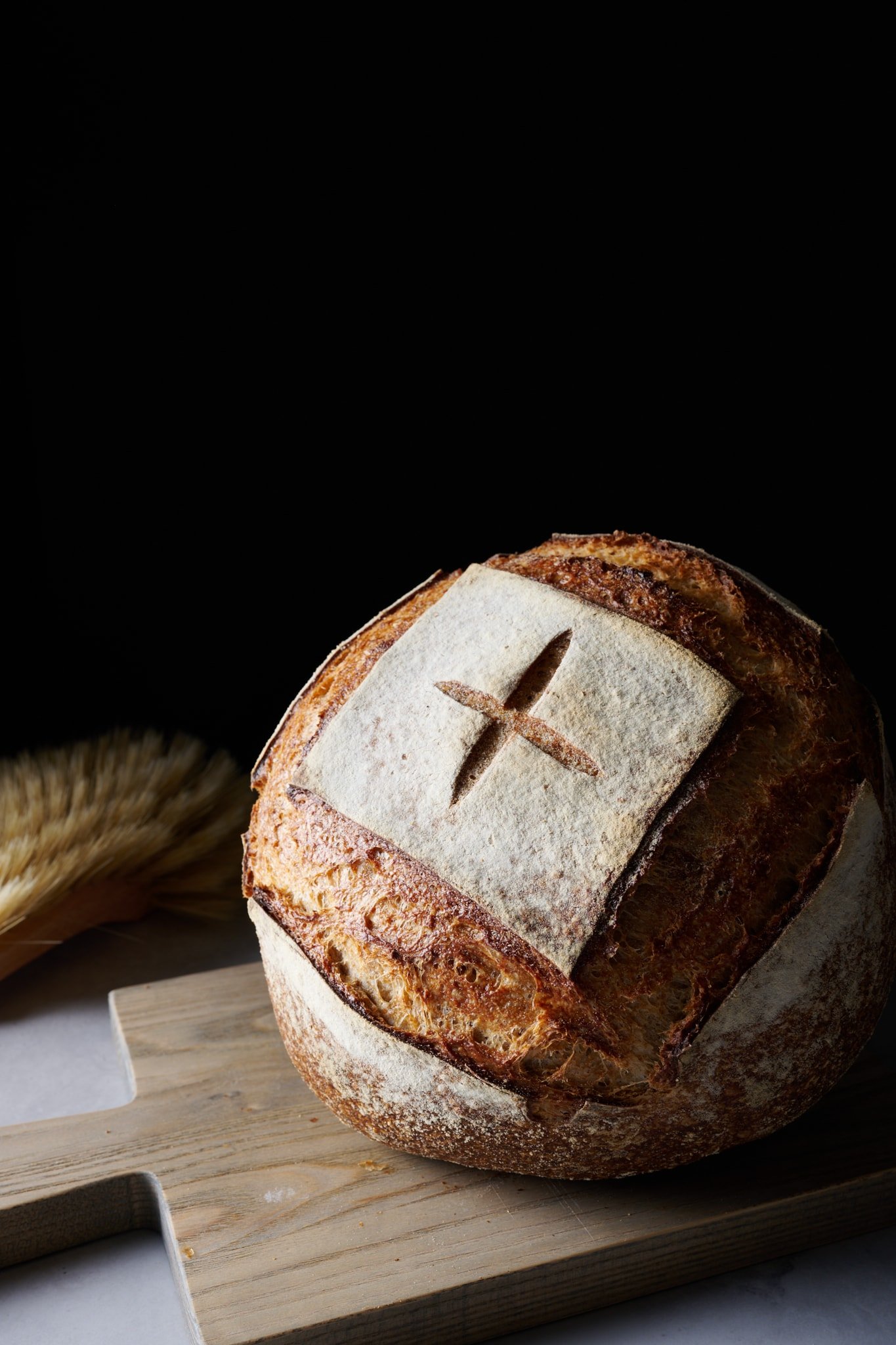
The Best Way To Bake Sourdough Bread With High-Protein Bread Flour
Here are a few of my to-go tactics for making sourdough bread with great texture, flavor, and nutrition, even when working with a high percentage of high-protein white flour.
(1) Increase Dough Hydration
In my experience, high-protein white bread flour requires an increase in the dough’s hydration (aka adding more water to a recipe that did not initially call for high-protein flour). No blanket percentage works for all flour, but for me, it’s usually an increase of 5 to 10% water to total flour weight in the recipe (in baker’s percentages—for example, if a recipe calls for 1000 grams of all-purpose white flour and 700 grams water; I would use 1000 grams high-protein flour and 800 or 850 grams water for a 10 to 15% increase). This added water will help produce bread that’s still soft and tender, despite the high gluten content.
Here’s why:
- Gluten Development: Water is necessary for gluten to form; adding a higher percentage of water will lead to a more flexible and loosely bound gluten network. This results in a crumb that’s more open and tender.
- Starch Gelatinization: More water in a dough helps gelatinize its starches during baking. Increased water in the dough will result in more thorough gelatinization and a softer texture.
Remember that adding more water to your dough can make it more challenging to work with because it’ll be slacker and stickier, making shaping more difficult. It’s always best to start with a small hydration increase and work up through subsequent test bakes.
(2) Use The Autolyse Technique
If you visit here often, you know I use the autolyse technique to help increase a dough’s extensibility and reduce the mixing time needed. As I discuss in my in-depth guide to the autolyse technique, it’s not a mandatory step but one I often use, especially with hand-mixed doughs.
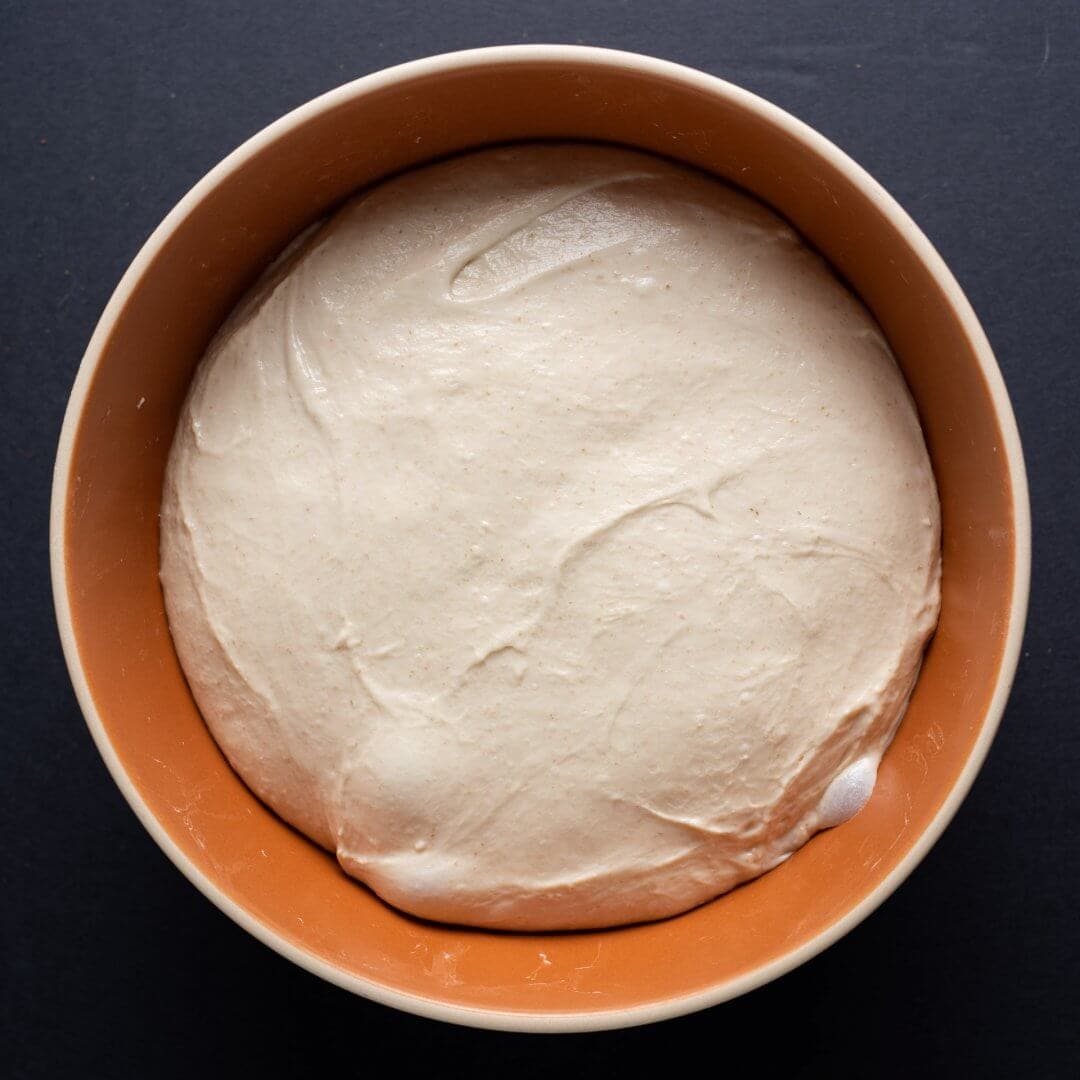
Surprisingly, a lot happens when you mix water and flour together and let it sit. But specifically with high-protein flour, it gives enzymes—in this case, most importantly, the protease enzyme—time to work. Protease breaks down protein bonds, which helps result in a dough that’s less elastic (minimizing the tendency of the dough contracting) and more extensible (allowing the dough to expand without tearing).
This is important because using a high percentage of high-protein white flour can produce a highly elastic dough that’s very tight and hard to stretch out during shaping.
(3) Mix and Knead the Dough Less
Because the flour contains more gluten, you won’t need as much mixing to achieve the same overall level of dough development as you would if using all-purpose or medium-protein white flour. This means you can mix and knead the dough for less time and still achieve a dough that’s strong enough to keep shape until baking.
(4) Ferment Longer
Generally, dough with higher protein content can withstand longer fermentation before breaking down, resulting in spreading in the oven instead of rising high. This is especially true with long-fermented dough made with a sourdough starter or levain. This means you can push the final proof of a dough longer than if it was composed mostly of low or medium-protein white flour.
I find this very much the case regarding sourdough pizza dough. While it’s absolutely fine to use medium-protein white flour, such as standard all-purpose, for pizza dough, many pizza makers like to use higher protein flour and longer fermentation time to produce stretchable dough, especially with New York-style pizza, which is a little chewy.
Note: A common misconception is that Type 00 flour, often recommended to home cooks for pizza dough, is high-protein. This is incorrect, and the Italian “type” classification doesn’t say anything about protein percentage; it only indicates that it’s the finest and “whitest” of the flour the mill produces. Actually, Type 00 flour usually has a protein content similar to that of medium-protein white flour.

My Favorite High-Protein White Flours
Here’s a list of my go-to high-protein flour for anything from babka to bagels to sourdough bread with many mix-ins.
| Miller and Flour | Protein Percentage | Comments |
|---|---|---|
| Cairnspring Mills Glacier Peak | 13-14% | Strong, flavorful flour. Great for pretzels. |
| Central Milling High Mountain | 13.5% | My go-to flour for sourdough bagels. |
| Hayden Flour Mills Artisan Bread Flour | 12.1% | Strong flour, but not excessively so. Great for freeform loaves despite its slightly higher protein content. |
| King Arthur Baking Bread Flour | 12.7% | A good all-around staple bread flour great for beginner sourdough loaves and even focaccia. |
High-Protein White Bread Flour FAQs
What is your favorite high-protein flour to use?
I almost always use Central Milling High Mountain or King Arthur Baking Bread Flour when I need high-protein white flour.
Is high-gluten flour the same as bread flour?
They are both considered higher-protein flours than medium-protein flour, such as all-purpose flour, which is typically around 11% protein.
Can I substitute bread flour for high-gluten flour?
Generally, yes. “Bread flour” typically refers to flour that’s higher in protein and at least 12%. High-gluten flour can also range between 12% to 15% or more. When I read “high-gluten flour,” I typically look for flour that’s 13% to 14% or more. With most flour, the miller should list the protein percentage directly on the bag, if not, a quick search online or an email to the miller will help you find this information.
Is high-gluten flour the same as “strong flour?”
Yes, these terms refer to the same flour stronger than typical all-purpose or medium-protein white flour.
What’s Next?
I hope this guide helps you navigate the confusing high-protein white bread flour category the next time you search for the perfect flour for your sourdough bread. Again, it’s flour that absolutely has its uses in the kitchen, though it is one that I am hesitant to use unless the need truly is there.
If you’re looking to use high-protein white flour, my sourdough bagels and sourdough pretzels are two perfect places to put it to work!


